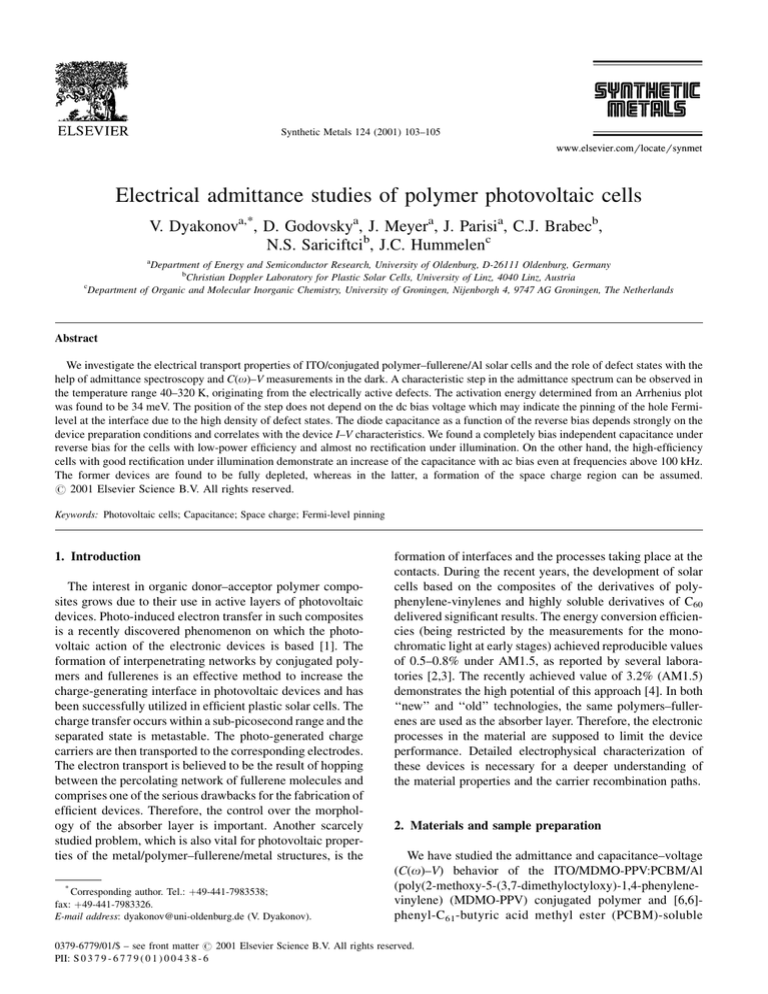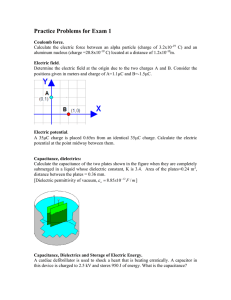
Synthetic Metals 124 (2001) 103–105
Electrical admittance studies of polymer photovoltaic cells
V. Dyakonova,*, D. Godovskya, J. Meyera, J. Parisia, C.J. Brabecb,
N.S. Sariciftcib, J.C. Hummelenc
a
Department of Energy and Semiconductor Research, University of Oldenburg, D-26111 Oldenburg, Germany
b
Christian Doppler Laboratory for Plastic Solar Cells, University of Linz, 4040 Linz, Austria
c
Department of Organic and Molecular Inorganic Chemistry, University of Groningen, Nijenborgh 4, 9747 AG Groningen, The Netherlands
Abstract
We investigate the electrical transport properties of ITO/conjugated polymer–fullerene/Al solar cells and the role of defect states with the
help of admittance spectroscopy and C(o)–V measurements in the dark. A characteristic step in the admittance spectrum can be observed in
the temperature range 40–320 K, originating from the electrically active defects. The activation energy determined from an Arrhenius plot
was found to be 34 meV. The position of the step does not depend on the dc bias voltage which may indicate the pinning of the hole Fermilevel at the interface due to the high density of defect states. The diode capacitance as a function of the reverse bias depends strongly on the
device preparation conditions and correlates with the device I–V characteristics. We found a completely bias independent capacitance under
reverse bias for the cells with low-power efficiency and almost no rectification under illumination. On the other hand, the high-efficiency
cells with good rectification under illumination demonstrate an increase of the capacitance with ac bias even at frequencies above 100 kHz.
The former devices are found to be fully depleted, whereas in the latter, a formation of the space charge region can be assumed.
# 2001 Elsevier Science B.V. All rights reserved.
Keywords: Photovoltaic cells; Capacitance; Space charge; Fermi-level pinning
1. Introduction
The interest in organic donor–acceptor polymer composites grows due to their use in active layers of photovoltaic
devices. Photo-induced electron transfer in such composites
is a recently discovered phenomenon on which the photovoltaic action of the electronic devices is based [1]. The
formation of interpenetrating networks by conjugated polymers and fullerenes is an effective method to increase the
charge-generating interface in photovoltaic devices and has
been successfully utilized in efficient plastic solar cells. The
charge transfer occurs within a sub-picosecond range and the
separated state is metastable. The photo-generated charge
carriers are then transported to the corresponding electrodes.
The electron transport is believed to be the result of hopping
between the percolating network of fullerene molecules and
comprises one of the serious drawbacks for the fabrication of
efficient devices. Therefore, the control over the morphology of the absorber layer is important. Another scarcely
studied problem, which is also vital for photovoltaic properties of the metal/polymer–fullerene/metal structures, is the
*
Corresponding author. Tel.: þ49-441-7983538;
fax: þ49-441-7983326.
E-mail address: dyakonov@uni-oldenburg.de (V. Dyakonov).
formation of interfaces and the processes taking place at the
contacts. During the recent years, the development of solar
cells based on the composites of the derivatives of polyphenylene-vinylenes and highly soluble derivatives of C60
delivered significant results. The energy conversion efficiencies (being restricted by the measurements for the monochromatic light at early stages) achieved reproducible values
of 0.5–0.8% under AM1.5, as reported by several laboratories [2,3]. The recently achieved value of 3.2% (AM1.5)
demonstrates the high potential of this approach [4]. In both
‘‘new’’ and ‘‘old’’ technologies, the same polymers–fullerenes are used as the absorber layer. Therefore, the electronic
processes in the material are supposed to limit the device
performance. Detailed electrophysical characterization of
these devices is necessary for a deeper understanding of
the material properties and the carrier recombination paths.
2. Materials and sample preparation
We have studied the admittance and capacitance–voltage
(C(o)–V) behavior of the ITO/MDMO-PPV:PCBM/Al
(poly(2-methoxy-5-(3,7-dimethyloctyloxy)-1,4-phenylenevinylene) (MDMO-PPV) conjugated polymer and [6,6]phenyl-C 61-butyric acid methyl ester (PCBM)-soluble
0379-6779/01/$ – see front matter # 2001 Elsevier Science B.V. All rights reserved.
PII: S 0 3 7 9 - 6 7 7 9 ( 0 1 ) 0 0 4 3 8 - 6
104
V. Dyakonov et al. / Synthetic Metals 124 (2001) 103–105
derivative of C60) structures. The cells of 15 mm 15 mm
size were fabricated by spin-coating of the polymer–fullerene in p-xylene solution (1:3 weight ratio) on top of a
patterned ITO contact on a glass substrate. We compare two
different types of solar cells: low-energy conversion efficiency (Ze < 0:5%) cells and high-energy conversion efficiency (Ze ¼ 2:5%) cells. Admittance measurements in the
frequency range 0.1–10 MHz have been performed using a
Solartron impedance analyzer 1260A equipped with a Solartron dielectric interface 1296A in combination with a variable temperature helium cryostat (T ¼ 40–320 K). The
measurements were carried out at an ac level of 50 mV in
order to work close to the equilibrium which can be distorted
due to high injection of charge carriers at forward bias. The
same set-up allowed to carry out C(o)–V measurements
whereby the ac voltage was superimposed with a dc bias
between 2 and þ2 V.
steps are expected. Fig. 1 shows the C(o) response of an
ITO/MDMO-PPV:PCBM/Al device at different temperatures. One step can be clearly seen. In the differentiated
capacitance spectrum (Fig. 1, right), this step appears as a
minimum, which enables to reveal the position of the step on
the frequency axis more accurately. The position of the step
does not depend on the bias applied, however, the step shifts
to lower frequencies when cooling down the device from
300 to 40 K. The latter is indicative for a thermally activated
process with an activation energy EA ¼ 24–34 meV corresponding to a shallow trap level (Fig. 2, left).
The C(o, T) behavior in the high-efficiency cells is
essentially the same. The same step is observed showing
similar values of the thermal activation energy. As shown
in Fig. 2 (right), the capacitance decreases with increasing
frequency. Under applied bias from 2 to þ2 V (T ¼ 40 K),
the position of the step does not shift along the frequency
axis.
3. Admittance spectroscopy
4. Capacitance–voltage measurements
The frequency-dependent contribution to the complex
admittance, Y ¼ G þ ioC, can originate from the trap levels
located in the bulk of the semiconductor material or at the
interface. The presence of such states can be seen in the C(o)
dependence (o: angular frequency), where the characteristic
We carried out C(o)–V measurements to reveal the presence of a space charge region, as a further contribution to
the device capacitance. Fig. 3 demonstrates the C(o)–V
behavior.
Fig. 1. Capacitance (left) and differential capacitance (right) of an ITO/MDMO-PPV:PCBM/Al cell measured at different temperatures.
Fig. 2. Frequency minima derived from Fig. 1 (lnðo0 Þ ðEA =kÞð1=TÞ) (left). Capacitance vs. frequency at different temperatures and dc bias (right).
V. Dyakonov et al. / Synthetic Metals 124 (2001) 103–105
105
Fig. 3. C(o)–V dependence at T ¼ 293 K in ‘‘low-efficiency’’ cell (left) and ‘‘high-efficiency’’ cell (right).
We found a bias independent capacitance under reverse
bias in the ‘‘low-efficiency’’ cell. This indicates that
the device is fully depleted. Surprisingly, the capacitance
increases and shows a peak at forward bias. Although, we do
not have a conclusive model to explain the appearance of
the capacitance peak and even a further increase of the
capacitance under charge injection conditions, the possible
reason can be a charge accumulation layer at the metal/
polymer and/or the metal/fullerene interfaces [5], or polymer–fullerene defects.
The C(o)–V dependencies of the ‘‘high-efficiency’’ cells
differ drastically from the ones observed for ‘‘low-efficiency’’ devices, especially in the frequency range above
10 kHz (Fig. 3, right).
5. Discussion
The full set of the experimental data allows us to conclude
that the electrically active defect states, which we observe in
the C(o) dependencies, are situated at the metal/polymer
composite interface. The bias independent position of the
step is an evidence for the Fermi-level pinning at the interface due to the high density of the defect states. We ruled out
the bulk defects, since the process of bulk defect ionization
in conjugated polymers consists of the hopping of a hole
from the conjugated segment with an acceptor impurity
(compensated state) to the neighboring conjugated segment.
Such hopping should be bias dependent due to the effective
lowering of the potential barriers in high electric fields
(Pool–Frenkel mechanism).
Since the high-frequency capacitance at 40 K practically
coincides with the calculated geometrical capacitance of the
sample, we conclude that we do not observe the conformational polymer chains relaxation processes (dipole relaxation), which take place at much higher frequencies.
The analysis of temperature dependencies of the capacitance (C ðexp(1/kT))1/2) along with the shape of the
C(o)–V curves at 293 K (Fig. 3, right) draws us to the
conclusion of a partial formation of the space charge layer at
room temperature in the case of the ‘‘high-efficiency’’ cell
(non-uniform distribution of free charge carriers throughout
the device). The increase in the charge carrier concentration
under illumination leads to an improvement of the space
charge layer, resulting in a high rectification ratio and an
increase in the filling factor (from 0.3 to 0.55) for ‘‘highefficiency’’ cells. This is possible only by assuming that the
charge carrier concentration in the ‘‘high-efficiency’’ cell is
already in the range above 1014 cm3.
The behavior of the capacitance in the low-frequency
range is well described in the frame of the Maxwell–Wagner
representation, providing additional evidence for the high
density of states at the metal/polymer interface.
6. Conclusions
We have examined the electrical transport properties of
novel polymer–fullerene solar cells by means of admittance
spectroscopy in the temperature range 40–320 K. We detect
electrically active shallow acceptor levels with EA ¼ 24–
34 meV situated, from our point of view, at the metal/
polymer composite interface. The high density of interfacial
states leads to the pinning of the Fermi-level. In contrast to
the ‘‘low-efficiency’’ cell, the admittance spectra of the
‘‘high-efficiency’’ device provide evidence for the formation
of the space charge layer at the metal/polymer composite
contact, explaining the high rectification ratio and improved
filling factor: two important parameters determining the
increase in the cell efficiency.
References
[1]
[2]
[3]
[4]
N.S. Sariciftci, et al., Science 258 (1992) 1474.
G. Yu, et al., Science 270 (1995) 1789.
Website: http://www.ipc.uni-linz.ac.at/plastic/page3.html.
C.J. Brabec, in: Proceedings of the 16th European Photovoltaic Solar
Energy Conversion Conference, Glasgow, UK, 2000.
[5] I.H. Campbell, et al., Appl. Phys. Lett. 66 (1995) 3030.


